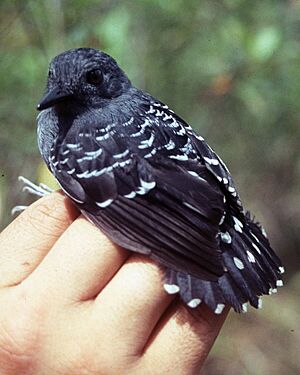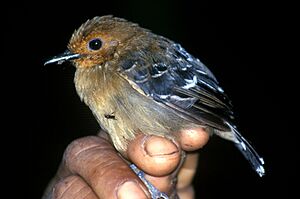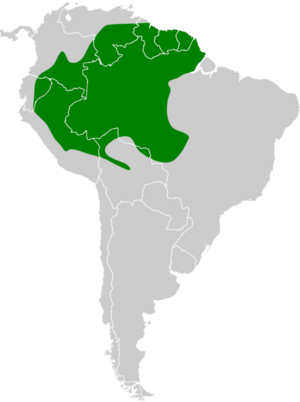Common scale-backed antbird facts for kids
Quick facts for kids Common scale-backed antbird |
|
|---|---|
 |
|
| Male, Cordillera del Cóndor, Ecuador | |
 |
|
| Female, Cordillera del Cóndor, Ecuador | |
| Conservation status | |
| Scientific classification | |
| Genus: |
Willisornis
|
| Species: |
poecilinotus
|
 |
|
| Synonyms | |
|
|
The common scale-backed antbird (scientific name: Willisornis poecilinotus) is a small bird found in the rainforests of South America. It belongs to a group of birds called "typical antbirds." You can find this bird in countries like Bolivia, Brazil, Colombia, Ecuador, French Guiana, Guyana, Peru, Suriname, and Venezuela.
Contents
About Its Name and Family
The common scale-backed antbird has had a few different names over time. A German bird expert named Jean Cabanis first described it in 1847. He gave it the scientific name Hypocnemis poecilinotus. The "poecilonotus" part of its name comes from ancient Greek words meaning "spotted back." This describes the bird's unique look.
Later, scientists realized this bird was not closely related to others in the Hylophylax group. So, they moved it to a new group called Dichropogon. But this name was already used for a type of fly! Because of this, scientists created the current group name, Willisornis, just for this bird.
Different Types of Scale-Backed Antbirds
There are five slightly different types, or subspecies, of the common scale-backed antbird:
- W. p. poecilinotus (found in Venezuela, the Guianas, and northeastern Brazil)
- W. p. duidae (found in Colombia, Venezuela, and northwestern Brazil)
- W. p. lepidonota (found in Colombia, Ecuador, and Peru)
- W. p. griseiventris (found in Peru, Bolivia, and southwestern Brazil)
- W. p. gutturalis (found in northeastern Peru and western Brazil)
These subspecies look quite different from each other. Because of this, some scientists think they might actually be separate species. Bird experts are still studying this to decide.
What Does It Look Like?
The common scale-backed antbird is about 12 to 13 centimeters (about 5 inches) long. It weighs between 15 and 22 grams (less than an ounce).
Male and Female Birds
- Males of the main type (W. p. poecilinotus) are mostly gray. Their upper parts are darker than their bellies. They have a white patch between their shoulders. Their lower back has black patches with white edges, which gives them their "scale-backed" name. Their wings and tail are black with white edges.
- Females of this type have a reddish-yellow-brown head and face. Their upper body is mostly olive-brown. They also have a white patch between their shoulders. Their lower back has brownish-black patches with buff (pale yellow-brown) edges. Their flight feathers are dark brown with reddish-brown edges. Their tail is dark olive-brown with white spots. Their throat is pale grayish-white. Their belly is gray with a reddish-yellow-brown tint.
Differences in Subspecies
The females of the other subspecies have some unique features:
- W. p. duidae females have a black lower back with wide white feather edges. Their tail is black with white spots. Their belly is reddish-yellow-brown.
- W. p. lepidonota females are similar to duidae but are paler. They have a browner head and a light buff center to their belly.
- W. p. griseiventris females have a reddish-buff face. Their lower back is plain. Their throat is pale gray, and their belly is gray.
- W. p. gutturalis males have a black throat. Their females look like lepidonota females but have a pale olive center to their belly.
Where Does It Live?
The common scale-backed antbird lives in the humid rainforests of South America. It prefers the lower parts of the forest, close to the ground. You can find it in different types of forests, including "terra firme" (forest on high, dry ground), "várzea" (forest that floods seasonally), and "igapó" (forest that is always flooded).
It lives at different heights depending on the country:
- In Brazil, it can be found up to 1,350 meters (4,430 feet) high.
- In Venezuela, it reaches 1,300 meters (4,265 feet).
- In Colombia, it is found up to 800 meters (2,625 feet).
- In Ecuador, it mostly stays below 700 meters (2,300 feet) but can go up to 1,100 meters (3,600 feet).
- In Peru, it is usually below 900 meters (2,950 feet) but can be found up to 1,350 meters (4,430 feet).
How Does It Behave?
Staying in One Place
The common scale-backed antbird is thought to live in the same area all year round. It does not migrate.
What It Eats
This bird mainly eats small creatures called arthropods, like insects and spiders. It has also been seen eating small lizards. It usually hunts alone, in pairs, or in family groups. It mostly looks for food within 1 meter (3 feet) of the ground. Sometimes it goes as high as 3 meters (10 feet), and rarely up to 5 meters (16 feet).
It often follows swarms of army ants. These ants stir up other insects and small animals as they move. The antbird then catches the creatures trying to escape the ants. However, it also hunts away from ant swarms. It catches prey by flying quickly from a perch to the ground, or to leaves, branches, and vines. It also probes and flicks through dead leaves on the ground.
Building a Nest and Raising Young
The breeding season for the common scale-backed antbird changes depending on where it lives. For example, it breeds from November to March in French Guiana. In Ecuador, it probably breeds from December to July. In Brazil, it might breed any month of the year.
These birds build different kinds of nests:
- Some nests are open cups made of dry leaves and other plant fibers. These are often built in palm trees.
- Other nests are cavities (hollows) lined with dead leaves.
- Some are unlined hollows at the top of a tree stump.
- One type is a cup of dried grass on the ground.
Usually, the female lays two eggs. The female sits on the eggs at night, but both parents take turns during the day. Both parents also feed and care for the baby birds. Scientists don't know exactly how long the eggs take to hatch or how long the babies stay in the nest.
What Does It Sound Like?
The common scale-backed antbird's song is usually a series of long, rising notes. Each note gets higher in pitch and louder, except for the last few notes, which get softer. The number of notes and other details can be different between individual birds and subspecies.
People describe its song differently:
- In Venezuela, it sounds like "pureeeee, pureeeee, pureeeee..."
- In Ecuador, it's "teeuw, tuweeé? tuweeé? tuweeé? tuweeé?"
- In Peru, it's "hew hui hui hui? hui? hui? hui? hui? hui?"
Its calls include a sharp "psit," a descending "chirr," a quick chitter, and a short whistle repeated 3-4 times. It also makes a longer whistle that falls and then rises in pitch, sounding like "cherri."
Its Conservation Status
The IUCN (International Union for Conservation of Nature) has listed the common scale-backed antbird as a species of "Least Concern." This means it is not currently in danger of disappearing. It lives across a very large area. Its total population size is not known, but it is believed to be stable.
Scientists have not found any immediate threats to this bird. It is considered quite common throughout its range. Many large protected areas are part of its habitat. Also, there are big areas of untouched forest where it lives that are not formally protected but seem safe for now.


